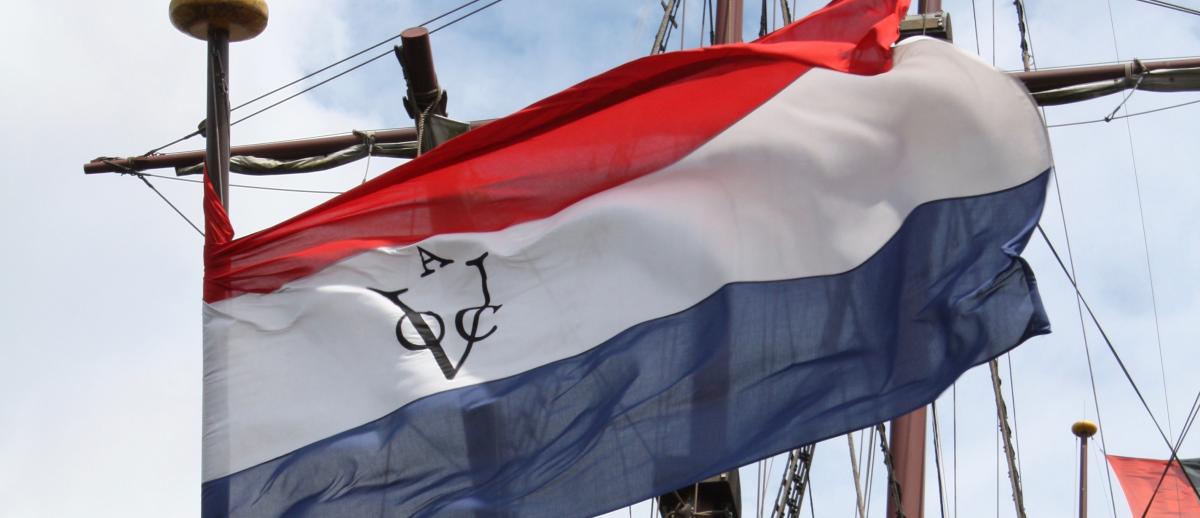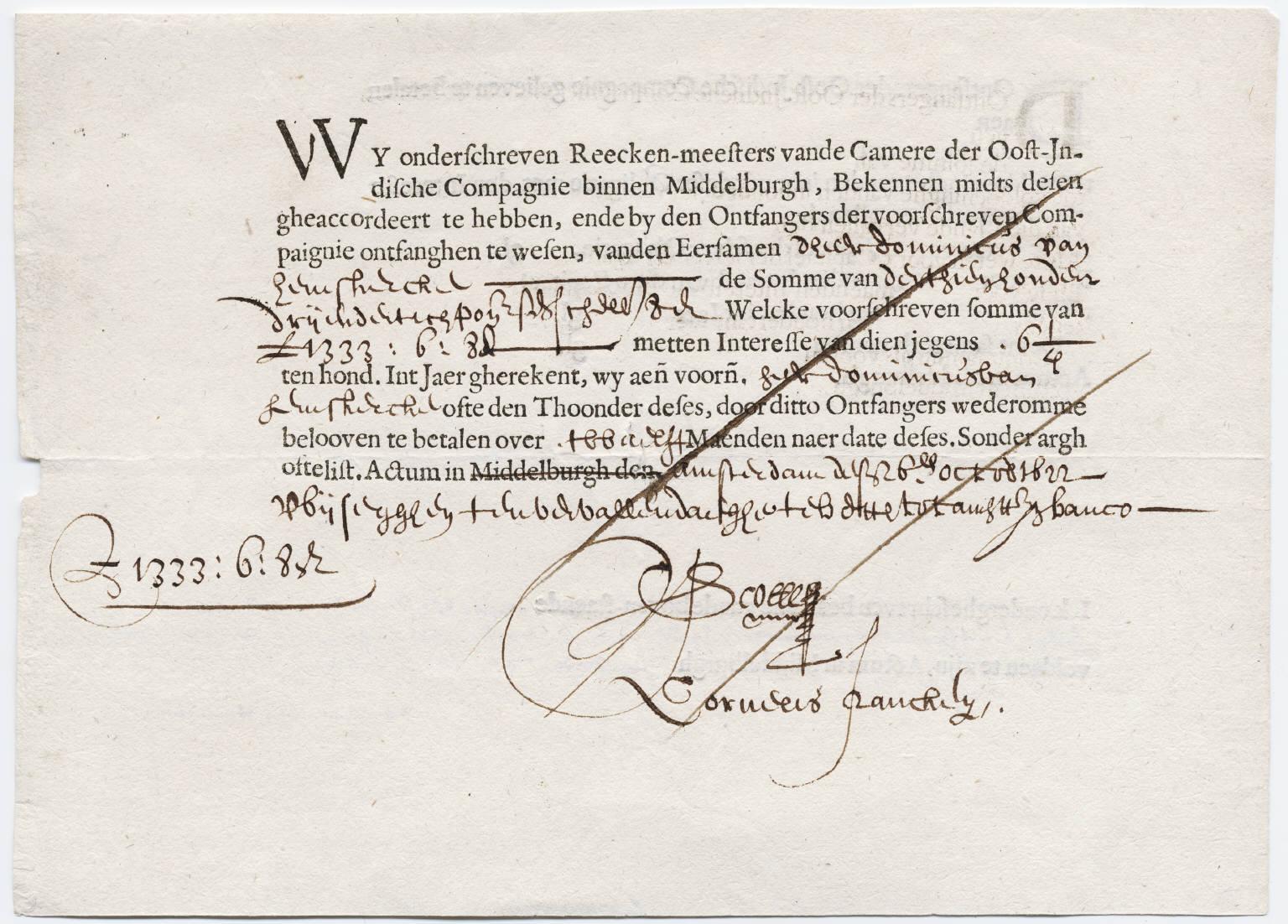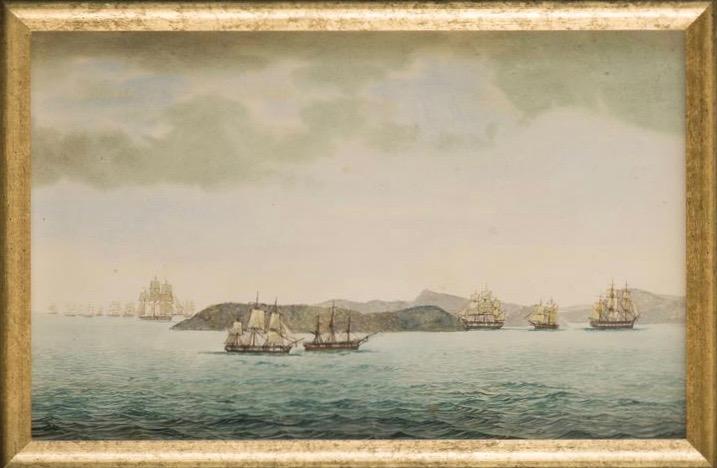A Tale of Two Global Corporations
archive


flag of the Dutch East India Company (VOC).
A Tale of Two Global Corporations
Under the title, The Original Evil Corporation, William Dalrymple recently assessed the British East Indian Company (EIC) as “an empire within an empire with the power to make war or peace anywhere in the East.”1 The EIC represents a taproot for the emergence of today’s global corporations, possessing a “fatal blend of power, money and unaccountability.” Nowadays they no longer need their own armies: national banks are ready to save them with their substantial bailout potentials, while secret services organize for them the bloody ‘regime changes’.
Dalrymple supposes that the EIC, as the most original evil corporation, “has no exact equivalents.” Here a remarkable vanishing trick is presented, for in fact the EIC could only reach the top after it had succeeded in ousting its Dutch predecessor and main competitor, the United East India Company, better known as the VOC (Vereenigde Oostindische Compagnie). This happened around 1760 when the VOC was kicked out of Bengal and lost its monopoly on the opium and other trades in Asia.
Exactly a century earlier the VOC had grasped this and other monopolies from the Portuguese, when the EIC was still a dwarf compared to the Dutch who possessed a fleet that was as large as all other European fleets together. The Dutch, European, and Asian history of the VOC cannot be told here, but it is relevant to point to some fundamental differences from the British EIC to alleviate the remarkable memory lapse of Dalrymple and others.2 So, why did the EIC succeed in toppling the still powerful VOC?
Strategic Errors
A VOC fleet arrived at the Bengal coast in 1759 to teach the EIC a lesson. However, aside from some logistic difficulties, the VOC made fundamental blunders: it did not realize that, after the 1757 Battle of Plassey (Palashi, north of Calcutta), the EIC could rely on a strong land-army under good leadership (not available to the VOC) combined with a Royal Navy possessing highly effective tall-masted warships (also not available to the VOC, notwithstanding their possession of more small ships). This was disastrous.
The Governor-General of the Dutch East Indies, Jacob Mossel, had served in the East Indian coastal region for about 15 years and he knew everybody (European and Indian) and everything about fraudulent business. On top of the military loss now came trouble with Mossel’s (and his Dutch Orangist friends') personal business with Bengal—opium, in the quantity of 1200 chests yearly since 1745. This business suddenly collapsed to about 500 and lower, as the EIC began to seize their resources and VOC lacked the power to retaliate because it had not recruited enough Indian military support.
Mossel now realized that the EIC had taken over in an irreversible way and that he had to depend on the EIC, rather than the reverse. But the new arrangements never really became his personal business because he died in 1761. Under these circumstances the VOC made the next blunder of not adopting the usual business strategy: ‘If you can’t beat them, join them!’ Such a move would have been appropriate then, thanks to a political alliance between ‘Royal London’ and ‘Merchant Amsterdam’. However, at the time, the VOC leadership in Asia was almost exclusively preoccupied with its own mega-luxury survival.
Ideological backgrounds
In addition to the above, some authors think it appropriate to point to ideological features to explain the demise of the VOC. This approach can be relevant if such issues are handled well, which is seldom the case.3 What could be defined as "ideology" in the 18th-century Asian territories occupied by the Dutch and English was nothing but offshoots of European religious thought. In the "Dutch territories" the occupiers were mostly Calvinists like Mossel from middle or lower classes; the few Dutch aristocrats were equals of the merchants, skippers, etc. For both, authority was strictly the “board” of the VOC (see below), but the Dutch rulers in Asia in fact did what they liked. In the "British territories" the Anglican monarchical hierarchy directly controlled from London was so organized that in the end the English queen became empress of India in the next century! Only the Royal Navy with a Royal Army on board was allowed to wage battles and wars. Mossel's haphazard Calvinist operation was no match for this Anglican royal discipline.

A bond from the Dutch East India Company (VOC), dating from 7 November 1623. (Source: Wikimedia)
So now that the VOC and EIC are perceived as the first evil multinationals with a far-reaching and important global impact, a concept like corporate self-perception becomes relevant. But this is a complicated question. First, there were serious discrepancies in the Netherlands between VOC-Amsterdam, VOC-Middelburg, etc., which acted largely autonomously; between the “17 Gentlemen” (who could have been a kind of VOC board, but instead handled largely personal affairs) and their supporters and enemies; and between these “17 Gentlemen” and the almost entirely neglected VOC shareholders. In the EIC case another difficulty arises since royal and aristocratic involvement undermined development of the EIC’s ‘corporate self-perception’ during its early history. Is the concept therefore empty, a misnomer when applied to the case of the VOC or EIC?
Company as a manifestation of the Dutch nation or Dutch state?
It must be emphasized that there is no such thing as a “Dutch nation” at the time under discussion. This is because the Netherlands then consisted of a series of seven gewesten—regions, erroneously called “provinces” as if they were part of an integrated state—which were often internally divided along roughly ethnic lines (Frisians, Saxons, etc.).
The rest of Europe, that is, monarchical Europe, was therefore confronted with a very exceptional phenomenon, a Republic of the Seven Regions. However, the inhabitants of this realm never perceived one nation, nor even seven nations. None of them deliberated about this concept at the time in the way Ernest Renan did 200 years later, and for centuries nobody perceived this corner of Europe as a kingdom even though there were several feudal constructions far above the heads of the inhabitants. As soon as a European king dared to alter this “silence” after 1500, he met with very serious and costly troubles.
What could be defined as "ideology" in the 18th-century Asian territories occupied by the Dutch and English was nothing but offshoots of European religious thought.
Moreover, no state existed because it was also impossible to establish a government or to make laws for seven regions. Different kinds of money circulated and nobody was obliged to accept a “monopoly of violence” wielded by a neighboring region. Again, no one deliberated about integration or nation. The Dutch word “staat” (state) at the time meant nothing but “position, situation,” or it was the name of a kind of manor. From 1593 onwards there was a “Staten Generaal,” which was nothing more or less than a periodic meeting of representatives of the seven regions who negotiated about taxes, war, and peace. Every gewest eventually had a “stadtholder” who was nothing but a local aristocrat as leader of a land-based militia. For the much more powerful and effective navy fleets there were arrangements in coastal regions of a strictly civil nature and leadership.
In short: this Republic of the Seven Regions was a loose communication-system called the Netherlands (Low Countries, Pays Bas) knit together by commerce, religion, common monarchical enemies, or socio-ecological necessities like the making of dikes and polders. But inside this system a ‘Trojan Horse’ had been running around since the Eighty Years’ War against Hapsburg Spain (1568-1648): the unreliable and controversial House of Orange with its remarkably stubborn and cruel Orangist support from aristocrats, civilians, and the scum of its two bases, the city of The Hague and the gewest Frisia. (Until today a common food in Frisia is called “orange cookies,” and a specific kind of hooligans wear “orange” outfits).
Orangist Flavor of Dutch Imperialism
During the latter half of the seventeenth century, the House of Orange upgraded its function as stadtholder in the gewest Holland as if it was a kind of monarch of all seven gewesten. By exploiting its position as military leader of the Republic’s land-based army in the struggle with (in particular) the monarch of Spain, the Organist’s were able to secure an overriding influence in VOC Asia. As they rose to power, they engaged in unbelievably cruel wars against all Asians; one of the VOC’s genocidal ‘highlights’ directly before the Bengal adventure entailed the slaughter of 20,000 unarmed Chinese men, women, and children in Batavia by Mossel’s colleague and predecessor, the aristocratic Orangist Van Imhoff, in 1742. Characteristic for the monarchical ideology of VOC Asia was a constellation of serious racism, superiority, fanatical religious behavior, and extreme forms of corruption and nepotism unseen in Amsterdam and other Dutch VOC cities.
The reverse situation existed in the UK which was always a monarchy, the only exception being the Calvinist Cromwell’s short rule (around 1650). Yet despite this difference the complexities of English-Dutch relations extended beyond the Bengal adventure in numerous ways. For example, the British picked up a Dutch stadtholder to make him English king in 1689 and around 1815 the British sent their Orange puppet to the Netherlands to become the first king of the Dutch, King William I.

British fleet en route to Java, 1811. (National Museum of Singapore)
Notwithstanding the Orangist influence, the VOC’s fierce Asian imperialism never resulted in a colonizing “evil corporation” like the royal EIC. After the Napoleonic wars, the British not only delivered the first king to the Dutch but created as well the first Dutch colonies. Stamford Raffles seized control of Java from 1811 until about 1826 to teach the Dutch how to colonize and systematically exploit foreign people. Their puppet King William ruled the new colonies as a personal possession and by means of one bloody war after the other.
By comparison, the VOC was much less systematic, though no less avaricious. And its leadership reflected this difference. The typical Calvinist of minor descent who climbed to the top of the VOC, Jacob Mossel, lost Bengal to the EIC and then moved on to Batavia where he showed little prowess for governance, but kept himself busy pocketing as much money as possible, only to be saved by his Orangist friends, including an Orange prince-stadtholder. Unsurprisingly, Mossel’s 1761 funeral in Batavia, in the midst of all kinds of turmoil, was as fabulous as that of a European monarch like Louis XIV—impossible in any Dutch city!
1. The New York Times, 7-9-2019.
2. A very recent English publication does not make this mistake: Thomas Clarke et al (Ed.), The Oxford Handbook of the Corporation (Oxford: OUP, 2019). The first chapter of the first part concerns ‘The Dutch East India Company...’ written by Paul Frentrop and the much smaller (!) second chapter describes ‘The English East India Company-State...’ written by Philip Stern. For the whole VOC opium story see now Hans Derks, History of the Opium Problem. The Assault on the East, ca. 1600-1950 (Leiden: Brill, 2012; 850 pp.).
3. See, for instance, the contributions of both Paul Frentrop and Philip Stern (note 2) or Anthony Pagden, Lords of all the world. Ideologies of empire in Spain, Britain, and France, c. 1500 – c 1800 (New Haven: Yale UP, 1995).



